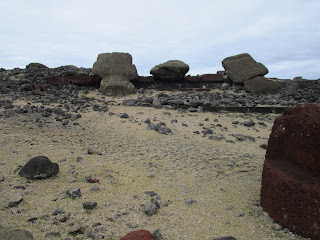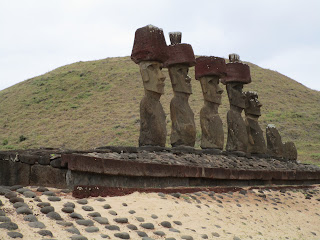 |
| The iconic Easter Island photo: 15 moai all lined up on a single platform, on the beach |
The stone heads of Easter Island are one of the world's great public art projects. Whatever else this is, whether it be religious, or honoring their ancestors, or just decorative, this is art and it should be appreciated as such.
 |
| The moai of Anakena, on the north shore of the island |
Easter Island is not one of those tourist destinations where you go: "Let's get away from the tourists and do something different." This is a place where you go: "Let's do what all the other tourists are doing. Let's go see the giant heads." And so I did.
You don't just walk outside your hotel and, suddenly, you find yourself in a field of giant stone heads. Although the island is quite small (I believe the circumference is about 26 miles, could be wrong, but that seems about right), one hires a guide who provides both transport and knowledge. Which I did. (And we saw precisely the same few guides with the same groups of tourists at each of the stops listed below.)
First stop: Vaihu, or Hanga Te'e.
Say, that doesn't look like a giant Easter Island head, does it? No. It's a house. Actually, more like a mansion.
This is a recreation of the type of village in which the early inhabitants lived, pre-European discovery. The houses, called hare paenga, or canoe houses (because they look like an upside-down canoe) were sleeping quarters only.
This was how the first inhabitants did their agriculture: in holes topped with rocks. This trapped the water.
It is not true that nothing grows on Easter Island. The early inhabitants farmed sweet potatoes and cassava. They also raised chickens, which they brought with them on the original canoes that landed here over a thousand years ago. That's why you see (and hear) chickens everywhere on this island.
This location is beachfront property. Next stop: Akahanga.
This site has a number of toppled statues, again, right on the beach.
And here's our first head, in a degraded and toppled form:
At one point, in the mid 19th Century, all of the statues were toppled. This process started well before European contact.
And here is a row of toppled heads.
Which, by the way, I need to stop calling them "heads." All were carved with full torsos, although the arms are not distinct from the body. When Europeans arrived in the mid-19th Century, many of the statues were submerged to degrees of varying significance in the soil. In this condition, the heads were more prominent. But heads and torsos were carved, and, in one instance, we will see coming up, one "moai," the proper name for these giant stone statues carved into human likenesses, one moai (and only one) had legs and feet.
This one, however, you may call a "head":
This one, however, is most definitely not just a head.
He looks more like a chubby beachgoer sunning himself on the beach.
The chubbiness is there to give the moai a lower center of gravity that made standing upright easier. But once they were toppled, the extra girth was no longer necessary.
Next stop: Rano Raraku. Probably the highlight of the day.
This is the quarry. This is not just where the volcanic stone used to carve the moai was quarried. This is where the stone was carved.
This where you really can just walk among the heads. I mean: walk among the moai.
Because this is where the moai were carved, the quarry has the largest concentration of moai on the island, by an order of magnitude. It is estimated that there are about 1000 moai on Easter Island and 400 of them are at the quarry site.
These two look similar, but not when you look more closely.
The one in the foreground has more detail, especially in the visible body. The one behind is just a head on a thick stone post. The ears, nose, and chin are all different. Could be carvings from different eras.
The one on the right is very familiar looking.
He's one of the most photographed of the moai. Probably because of the rakish tilt of the head on his broad shoulders. I also swear he was drawn in some Far Side cartoon. Gary Larson included a lot of Easter Island heads in his cartooning. Not as many as anthropomorphic cows and chickens, or fat little boys, but there were many. I swear he was one.
So, just to be safe, I posed in front of him. In case he's famous.
I liked this one.
Enough that I posed with him, too. Didn't want you to think that I only hang with the celebrities.
Again, this is where the most heads can be found.
And, nearby, is the most photographed stand of moai on the island.
But I'm getting ahead of myself.
This is the moai with legs and feet.
He's kneeling, which would give him the proper center of gravity, but from this angle you can distinctly see the legs and the feet curled up underneath him.
More moai, in various states of uprightedness:
This is a moai that was in the process of being carved.
This would've been the largest moai ever carved if it had been completed. Over 20 meters tall.
Among what's fascinating about the moai is that moai carving and moai erection all stopped suddenly sometime in the 1700's. This was well-before European arrival, so that had nothing to do with it. And by "suddenly," I mean nearly instantaneously. There was no winding down. It all stopped. Transport to the platforms stopped mid-journey. Carving was stopped in mid-carve. A changing climate, or over-population, or deforestation, or drought or famine would not explain the instantaneousness of the stoppage. It's just one of the mysteries of Easter Island that will remain a mystery. The cult of the moai was replaced by the cult of the bird-man, which I don't really understand and (hopefully) will learn about tomorrow when I visit the center of the bird-man cult.
The iconic photo of Easter Island. Fifteen moai lined up on a single "ahu," or mounting platform.
Only one of the 15 is wearing his hat, which is more properly called a "topknot."
Of course, I'm not wearing a hat either (a serious mistake since the sun is intense here even on an overcast day). Not all moai wore hats, or topknots.
This one wears his top knot because, when the moai were being re-erected in modern times, he was the only one whose hat (topknot!) still fit him. Because of damage to the head or the topknot, not all could be refitted with headgear. Him, for example.
He is quite the frowny-face, is he not?
Reverse side view:
Nearly all of the moai looked inward, into the island, backs to the beach or, in this case, with their backs turned on Chile. Protection? Companionship? No one is spilling their secrets.
Here are some disembodied heads at that site.
The second stone from the left, back row, has an E.T. "space alien" look to him, don't you think?
And here is the hat check counter at Tongariki.
These are a few of the topknots that could not be placed back on to the head tops, either because of damage during the toppling that occurred in the early 19th Century, or maybe from the tsunami that struck after a massive earthquake struck Valdivia on the Chilean mainland in 1960. How massive? A 9.5 on the Richter Scale, which would make the most powerful earthquake in the era of recorded earthquakes.
They've recovered nicely, for the most part.
Next stop: Te Pito Kura.
This arrangement of stones has been called "the navel of the world." The first inhabitants called the entire island "the navel of the world" and new age cultists have adopted this arrangement of stones as some energy vortex or another. It had no significance to the original inhabitants, but that hasn't stopped it from being a target of obsession with modern-day new age types. It's all because of that large round stone in the middle. Because of the stone's mass, and the very high iron content of the rock, it has its own magnetic field. It will affect compasses. Interesting, of course, but hardly a reason to endow this perfectly nice round stone with mystical forces.
And so we reach the final stop on the day's tour: Anakena.
There are multiple reasons why Anakena is interesting.
First, it is the only real sandy beach on the island. Most of the waterfront is volcanic rock. Great for fishing and diving. Terrible for "fun in the sun." When Easter Island residents go to the beach, this is where they go.
Second, this is where the original settlers of Easter Island disembarked after their journey of thousands of miles across open Pacific.
Third, the moai have their topknots.
Not all of them. Some in this line do not even have their head anymore.
Tough to wear a topknot well when you got no head.
And some only have their head and nothing else.
And let's end with this one.
Or, better yet, dogs on the beach with that moai in the background.
And that is the end of the tour.
I booked four nights on Easter Island, which means three days. I have my schedule for tomorrow, so Easter Island will be worth two full days. Not sure about that third day, but when I booked this trip -- knowing that my visit to Easter Island truly would be a "once in a lifetime" experience -- I did not want to take a chance on not having enough time.




























































No comments:
Post a Comment